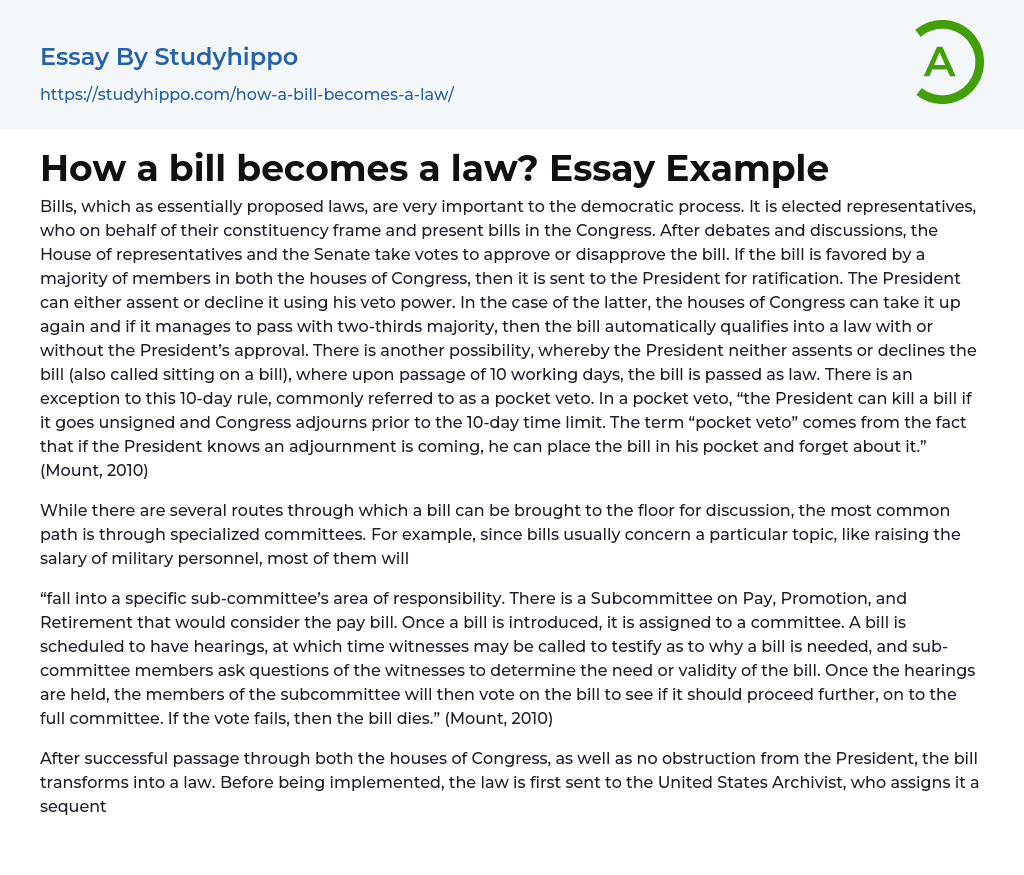Bills, which as essentially proposed laws, are very important to the democratic process. It is elected representatives, who on behalf of their constituency frame and present bills in the Congress. After debates and discussions, the House of representatives and the Senate take votes to approve or disapprove the bill. If the bill is favored by a majority of members in both the houses of Congress, then it is sent to the President for ratification. The President can either assent or decline it using his veto power. In the case of the latter, the houses of Congress can take it up again and if it manages to pass with two-thirds majority, then the bill automatically qualifies into a law with or without the President’s approval. There is another possibility, whereby the Presid
...ent neither assents or declines the bill (also called sitting on a bill), where upon passage of 10 working days, the bill is passed as law. There is an exception to this 10-day rule, commonly referred to as a pocket veto. In a pocket veto, “the President can kill a bill if it goes unsigned and Congress adjourns prior to the 10-day time limit. The term “pocket veto” comes from the fact that if the President knows an adjournment is coming, he can place the bill in his pocket and forget about it.” (Mount, 2010)
While there are several routes through which a bill can be brought to the floor for discussion, the most common path is through specialized committees. For example, since bills usually concern a particular topic, like raising the salary of military personnel
most of them will
“fall into a specific sub-committee’s area of responsibility. There is a Subcommittee on Pay, Promotion, and Retirement that would consider the pay bill. Once a bill is introduced, it is assigned to a committee. A bill is scheduled to have hearings, at which time witnesses may be called to testify as to why a bill is needed, and sub-committee members ask questions of the witnesses to determine the need or validity of the bill. Once the hearings are held, the members of the subcommittee will then vote on the bill to see if it should proceed further, on to the full committee. If the vote fails, then the bill dies.” (Mount, 2010)
After successful passage through both the houses of Congress, as well as no obstruction from the President, the bill transforms into a law. Before being implemented, the law is first sent to the United States Archivist, who assigns it a sequential numerical reference. The Archivist also releases a pamphlet about the new law, called the slip law. This pamphlet contains detailed information about the law, its origins, its context, other laws that would complement or conflict with it, etc. The law is then entered into the United States Statutes at Large as well as the United States Code. During this final step, sections and clauses that are irrelevant or obsolete are removed while new provisions are added. A compilation of these changes will be released in public domain once every six years.
Works Cited:
From Bill to a Law, Library of Congress Thomas, retrieved from
Mount, Steve, Constitutional Topic:
How a Bill Becomes a Law, retrieved from
It is self-evidently true that a liberal-democratic government should protect the ‘social rights’ of its citizens. There are copious arguments from various eminent thinkers that back up this claim. Ranging across eras and philosophical schools, various intellectuals have endorsed the protection of social rights of citizens. This essay will draw upon the ideas of philosopher Socrates (through his disciple Plato), American founding father James Madison, and 20th century political scientist T.H. Marshall. In doing so, the essay will back the position that a liberal-democratic government should protect the ‘social-rights’ of its citizens.
Social rights can be loosely defined as those rights which are operant in public places. While this is not a legal definition of the term, it serves as a guideline for the essay. In a nation with diverse racial, ethnic and religious demography as the United States, it is expected that the laws reflect secularism and social equity. These .
- Business Law essays
- Contract essays
- Consumer Protection essays
- Property essays
- Ownership essays
- Agreement essays
- Common Law essays
- Contract Law essays
- Justice essays
- Security essays
- Tort Law essays
- United States Constitution essays
- Crime essays
- Lawsuit essays
- Treaty essays
- Family Law essays
- Marijuana Legalization essays
- Constitution essays
- War on Drugs essays
- Court essays
- Jury essays
- Police essays
- Protection essays
- Community Policing essays
- Criminal Law essays
- Judge essays
- Lawyer essays
- Employment Law essays
- Copyright Infringement essays
- Injustice essays
- Intellectual Property essays
- Breach Of Contract essays
- Jurisprudence essays
- Social Injustice essays
- Juvenile Justice essays
- Internet Privacy essays
- Cyber Security essays
- Bill Of Rights essays
- Civil Liberties essays
- First Amendment To The United States Constitution essays
- Fourth Amendment To The United States Constitution essays
- Second amendment essays
- Animal Cruelty essays
- Law Enforcement essays
- Juvenile Justice System essays
- Surveillance essays
- Forensic Science essays
- Crime Prevention essays
- Criminal Justice essays
- Criminology essays




